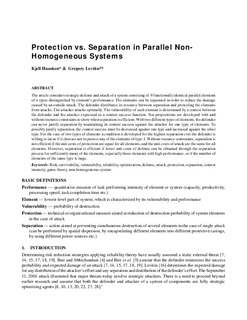| dc.contributor.author | Hausken, Kjell | |
| dc.contributor.author | Levitin, Gregory | |
| dc.date.accessioned | 2013-08-26T09:09:57Z | |
| dc.date.available | 2013-08-26T09:09:57Z | |
| dc.date.issued | 2009 | |
| dc.identifier.citation | Hausken, K. & Levitin, G. (2009) Protection vs. separation in parallel non-homogeneous systems. International Journal of Reliability and Quality Performance, 1(1), pp. 54-65 | no_NO |
| dc.identifier.issn | 0975-2102 | |
| dc.identifier.uri | http://hdl.handle.net/11250/184299 | |
| dc.description | Made available with the kind permission of the editor of International Journal of Reliability and Quality Performance (IJRQP). | no_NO |
| dc.description.abstract | The article considers strategic defense and attack of a system consisting of N functionally identical parallel elements
of n types distinguished by element’s performance. The elements can be separated in order to reduce the damage
caused by an outside attack. The defender distributes its resource between separation and protecting the elements
from attacks. The attacker attacks optimally. The vulnerability of each element is determined by a contest between
the defender and the attacker expressed as a contest success function. Ten propositions are developed with and
without resource constraints to show when separation is efficient. With two different types of elements, the defender
can never justify separation by maintaining its contest success against the attacker for one type of elements. To
possibly justify separation, the contest success must be decreased against one type and increased against the other
type. For the case of two types of elements a condition is developed for the highest separation cost the defender is
willing to incur if it chooses not to protect any of the elements of type 1. Without resource constraints, separation is
not efficient if the unit costs of protection are equal for all elements, and the unit costs of attack are the same for all
elements. However, separation is efficient if lower unit costs of defense can be obtained through the separation
process for sufficiently many of the elements, especially those elements with high performance, or if the number of
elements of the same type is large. | no_NO |
| dc.language.iso | eng | no_NO |
| dc.publisher | Serials Publications | no_NO |
| dc.subject | game theory | no_NO |
| dc.subject | risk | no_NO |
| dc.subject | survivability | no_NO |
| dc.subject | reliability | no_NO |
| dc.subject | defense | no_NO |
| dc.subject | attack | no_NO |
| dc.subject | protection | no_NO |
| dc.subject | contest intensity | no_NO |
| dc.title | Protection vs. separation in parallel non-homogeneous systems | no_NO |
| dc.type | Journal article | no_NO |
| dc.type | Peer reviewed | no_NO |
| dc.subject.nsi | VDP::Social science: 200 | no_NO |
| dc.source.pagenumber | 54-65 | no_NO |
| dc.source.volume | 1 | no_NO |
| dc.source.journal | International Journal of Reliability and Quality Performance | no_NO |
| dc.source.issue | 1 | no_NO |
